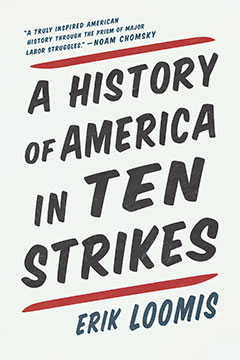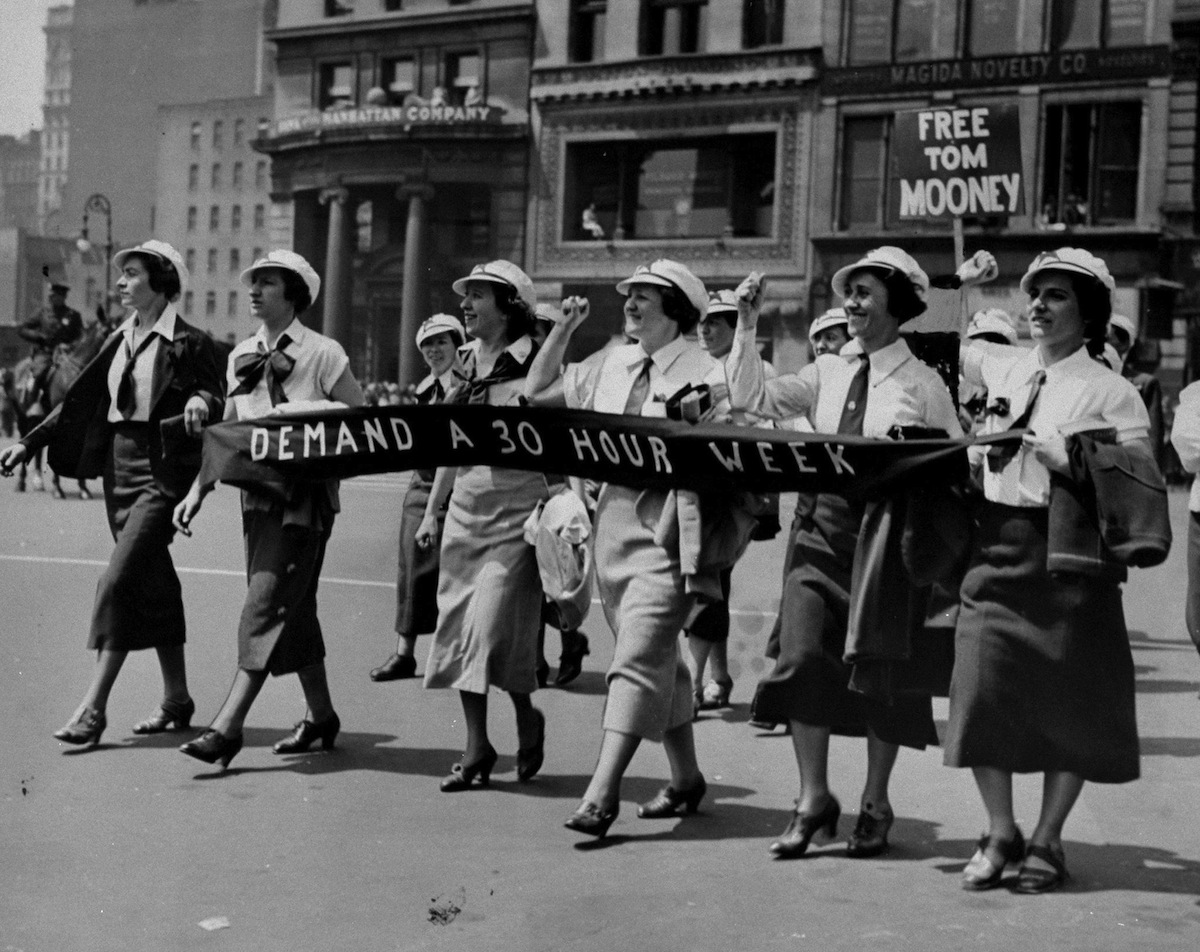What is Strike-to-Amend About?
Strike-to-Amend is a movement that is building support for a general strike in order to achieve comprehensive reforms to the United States Constitution. The Amendments are designed to achieve goals for society that are essential, popular, and continually discussed in public discourse, but will never be passed by ordinary political processes.
This strategy is based on (1) the past success of both strikes and constitutional amendments to produce permanent change in America, and (2) the lack of any other effective options to improve the lives of ordinary Americans (short of full revolution).
Unlike legislation, Constitutional law establishes policy routes for legislation, is more permanent because of higher democratic thresholds (i.e., supermajorities), and is not subject to the whims of a particular party in control at a given moment. And unlike an armed revolution, Constitutional amendments are a perfectly legal way of radical change without directly inviting the risks of violence and civil war.
The U.S. Constitution has been amended 27 times since it was originally passed, with the last Amendment ratified in 1992. Our conviction is that it needs to be amended another 27 times.
But we’re willing to compromise…
A Complete Package of Fourteen Amendments
Strike-to-Amend has prepared the draft of Fourteen Interconnected Constitutional Amendments that address everything from ecological sustainability, universal healthcare, healthcare debt and student loan forgiveness, affordable housing, public education, wealth and income inequality, qualifications for office, term limits, children’s rights, reproductive rights, worker ownership and workplace democracy, preferential voting, and supreme court expansion and election by the public, to the abolishment of the electoral college, executive immunity, the two-party system, torture and the death penalty, unlimited war, absentee landlording, exploitative corporations, private for-profit prisons, the filibuster, plea bargaining, mandatory minimum sentences, military tribunals, campaign donations and legal bribes, and so many more embarrassing and destructive features of contemporary American society.
The Constitution is a country’s “operating system,” and today, in the 2020s, the United States is currently running on the equivalent of Window 95. The changes in both the political climate and the weather itself are also indicating that we have out of time: radical change must happen now.
None of these essential policies can, have, or will come to pass by voting within the current two-party (one-party) system. There are no financial incentives for political leaders to pass legislation against the interest of their own corporate donors. History has demonstrated this problem repeatedly. The government must be forced, by a general strike, to pass permanent changes to the US Constitution.
It’s happened before. It can and must happen again.
Why?
The American experiment is now well past its hey-day. “State-capture” is complete, and there is no recourse for working class people to achieve power and positive change over their own lives. There is no functioning democracy, corruption is legalized and normalized, all three branches of government are broken and subject to corporate power, and all of these structural and systemic weaknesses are exploited by the worst of actors—whether outright fascists, religious fundamentalists, and otherwise. While some of these general problems have been a challenge since the late 1700s (which is why the Constitution has already been amended so many times), it is even more true in the twenty-first century.
Consider the following facts:
1. Studies have shown that 80-95% of American primary elections are bought and sold to the highest bidder. This is not how a functional, authentic democracy operates. Many countries forbid bribes and campaign donations for obvious reasons, and also place restrictions on political candidates for conflict of interest. This is an extremely low bar for integrity. America has yet to cross it.

2. Studies have shown that the government does not represent the people; most policies do not actually reflect what people want. A true democracy allows the people to have super majority veto power over any government decision by public referendum to prevent this problem. A true democracy also has a democratic executive branch. America has neither. It has no public veto, and it has essentially a king (left over from British monarchy) instead of a plural body like the legislature and Supreme Court. This creates distance between the government and the people, and layers of misrepresentation.
3. The two-party system is notorious for preventing positive change. Both parties (Democratic and Republican) are controlled by the same corporations whose only concern is to maximize shareholder profit, not take care of citizens. This is a “conflict of interest” on the largest possible scale.


4. Living standards are declining significantly even as government spending and deficits soar. Wages are lagging, healthcare costs are so high that medical bankruptcy is an industry, and owning a house is now little more than an American “dream,” and not a possibility.



5. All data is blinking red with regard to the habitability of our planet. Global neoliberalism has commodified enough of the earth, its resources, and the social system to destroy the biosphere entirely. Playing electoral politics and the game of “gradual incremental change” is suicidal for all life on earth.

How, Then, Can We Change the System?
Strike-to-Amend primarily exists to (a) provide the text of comprehensive amendments to the U.S. Constitution that fixes our country’s biggest problems and (b) to bring awareness and gather sufficient commitments (at least 5% of the U.S. population, or 17 million people) for a general strike to pass this legal program within a single year sometime in the future.
But, why a strike? Can we just vote our way out of this?
No, we can’t. In a world centered on private profit, there are no financial incentives to save the planet or intentionally improve society. Politicians only do what their corporate donors tell them to do.
Corporations have a fiduciary duty to profit shareholders, not benefit workers. The Scottish economist and ethicist Adam Smith (1723-1790) realized that the relationship between workers/employees and capitalists/employers is inherently unequal. The same obviously goes with the relationship between citizens and the state, especially a state that is not functionally democratic (see above). There is really no way for workers to “negotiate” radical improvement in either situation. They must simply obey their corporate or political overlords. In Smith’s words:
The workmen desire to get as much, the masters to give as little as possible. The former are disposed to combine in order to raise, the latter in order to lower the wages of labour.
It is not, however, difficult to foresee which of the two parties must, upon all ordinary occasions, have the advantage in the dispute, and force the other into a compliance with their terms. The masters, being fewer in number, can combine much more easily; and the law, besides, authorizes, or at least does not prohibit their combinations, while it prohibits those of the workmen. We have no acts of parliament against combining to lower the price of work; but many against combining to raise it. In all such disputes the masters can hold out much longer. A landlord, a farmer, a master manufacturer, a merchant, though they did not employ a single workman, could generally live a year or two upon the stocks which they have already acquired. Many workmen could not subsist a week, few could subsist a month, and scarce any a year without employment. In the long run the workman may be as necessary to his master as his master is to him; but the necessity is not so immediate.
We rarely hear, it has been said, of the combinations of masters, though frequently of those of workmen. But whoever imagines, upon this account, that masters rarely combine, is as ignorant of the world as of the subject. Masters are always and everywhere in a sort of tacit, but constant and uniform combination, not to raise the wages of labour above their actual rate. (An Inquiry into the Nature and Causes of the Wealth of Nations, Book I)
The only weapon the 99% have—other than actual weapons—is the strike: withholding our labor until change happens.

Strikes remind the ruling class—and the rest of the world—that all of society and our economy depends upon the labor of ordinary people. More importantly, if strikes are large enough, rulers must obey the demands of the working majority. Why? Because no one can make money, including every billionaire and politician on the planet, without our labor. That is why a general strike, an economy-wide strike, can be so effective.
Strikes—not voting, legislation, or even public protests—are the most effective way to achieve policy change. It was on his way to a strike that MLK Jr. was assassinated. It was only after strikes that racial segregation ended in America. It was only after strikes that women gained the right to vote. It was only after strikes that workers gained significant rights as workers. It was only after strikes and withholding resources that South African apartheid fell. This is a story that is much older than America’s brief history. (In fact, the first strike was held by workers in ancient Egypt in 1170 BCE). Strikes, just like slave rebellions, are a central tipping point for societal change.
Organizing a general strike will require collaboration between many organizations, parties, and groups. It will cross ideological lines. It may take several years to organize. But it will be worth it.
Aren’t Public Protests Enough?
No, they are not. Protests and even revolutionary movements without concrete political goals achieve little more than awareness.
Awareness is important, but only the first step towards real change. Hammering wood will not build a house until the hammer is directed on nails in just the right places. Yes, it will make noise and get people’s attention, but it’s not enough to change the system or build something new.
More sobering, is that mass movements without concrete and specific policy change reinforces the status quo of oppression. Consider the following examples:
- 1848 Revolutions in Europe: The 1848 Revolutions, a series of political upheavals across Europe, were driven by demands for democratic reforms, national independence, and economic rights. Despite initial successes in some regions, the movements ultimately failed to achieve lasting change as conservative forces regained control and restored the status quo.
- 1968 Protests: The 1968 protests, characterized by student-led demonstrations and widespread unrest across the globe, were sparked by opposition to authoritarianism, war, and social inequality. They brought attention to important social issues and led to some reforms, but the movements did not achieve the deep structural changes they sought, and established powers maintained their dominance.
- 2020 Black Lives Matter (BLM): Another global protest movement, which aimed to address systemic racism and police brutality, particularly against Black people. Despite raising significant awareness, the protests struggled to secure comprehensive reforms or dismantle entrenched systems. In fact, police brutality only increased, and more and more private prisons were built ever since.
In short, protests that don’t succeed in changing the system have the opposite effect: they reinforce the existing systems and re-assure the ruling class that things will return to equilibrium after fires in the streets are put out. Protests without policy change is just a protest.





